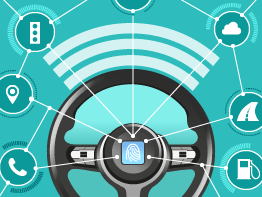
A time-traveller from 1910s wouldn’t be too impressed by the sight of a regular modern sedan. Still no flying cars in the year 2017? What a waste. However, let this hypothetical sceptic inside to demonstrate what this unassuming vehicle can do (besides driving us places) and watch their jaw drop.
Our cars let us control the climate inside, easily navigate unfamiliar routes, listen to music, watch videos, get reminders to wear a seatbelt, and so much more. What was essentially a mechanical cart evolutionized into a smart piece of tech — and we keep teaching it new skills to make our own lives safer and easier.
The next step in this evolution is the connected car that relies on Internet access to deliver a wide range of intelligent features that transform the whole digital experience for the driver and passengers.
How Connected Cars Work
Just 10 years ago, the volume of data generated by a moving vehicle couldn’t be reliably transferred, processed, and acted upon fast enough to deliver value. It was the recent rise in big data-related solutions, accompanied by advances in mobile connectivity and cloud computing that created a favorable environment for the connected car technology.
Fitted with dozens of sensors and a wireless Internet connection, the car is able to transmit real-time data on location, speed, direction, driver behavior, engine temperature, oil and tire pressure, suspension settings, etc., etc. — which is then processed remotely by any number of specialized applications and turned into insights. At the same time, the onboard computer receives up-to-date information from the outside world.
Great, But What Does It Do?
The constant interchange of information between your vehicle and the world gives it the ability to factor congested highways and construction sites into your route, assist you with finding the nearest parking spot, or advise you on the optimal fuel consumption to make the journey cost-efficient, for starters.
Using a smartphone interface, you can use all the familiar mobile apps on a bigger screen or operate your car’s systems remotely, say, to switch on the heating in advance so that it’s nice and toasty inside when you’re ready to leave work.
You are also bound to have a safer driving experience when your car can warn you about any issue in the vehicle’s systems, much like modern racecars do via telemetry. Some connected cars offer solutions that detect a driver’s fatigue and keep them alert to prevent accidents. And if an accident does happen, the car can save precious minutes by immediately sending out an SOS signal to the nearest hospital, accompanied with data on the force of the impact.
All software updates and patches are sent over-the-air, saving the owners a trip to the car service. In some cases, manufacturers can even leverage emergency software updates, as demonstrated lately by Tesla who boosted their vehicles’ battery capacity to help owners flee from Hurricane Irma in Florida.
The Intelligent Cars of Tomorrow
At the moment, available solutions for connected cars are centered around a single vehicle and the comfort of the people in it. However, when the majority of drivers will own connected cars, it will be possible to make them all “aware” of each other, creating a network of vehicles that can react to each other’s sudden movements faster than their drivers are able to, especially in poor visibility conditions.
As one of the most innovative automotive companies in the world, Tesla announced cloud-based driver profiles, which means that in the future, your preferences and personal settings will automatically apply to any Tesla vehicle you drive.
In fact, connected cars are gradually paving the way for fully autonomous vehicles as the next frontier for the industry. The ability of self-driving cars to detect and recognize multiple objects depends heavily on advances AI and specifically deep learning technology. Uber has already rolled out a trial of its self-driving fleet in Arizona, while Google’s Waymo invites to join their early rider program — a public trial of self-driving cars.
The Challenges of Adoption
As cars are getting more and more technologically complex, new challenges arise. The major concern with cloud connectivity is cybersecurity — new in-vehicle services and infotainment systems dramatically increase the attack surface. Many customers fear that hackers could get control over their vehicles, tamper with the systems, and even cause accidents.
In this regard, the goodwill gesture of Tesla for those fleeing Hurricane Irma was also a testament to how little control the owners actually have over their own vehicles.
Yet another issue at hand is data privacy, as intelligent technologies constantly gather information about our lifestyle and preferences. With your car turning into a sophisticated data-collecting device, the question arises how much of your personal information you are willing to share.
The Push Behind the Technology
According to Gartner, by 2020 there will be 250 million connected cars on the roads. Even with issues listed above, the opportunities that such an influx of data can bring are too great to pass on.
Now that vehicles are capable of two-way communication, they have become a battleground for adtech companies with fierce competition over the consumers’ attention. A good example is Adobe with its automotive-focused analytics added to Adobe Experience Cloud. The feature will provide brands with a platform to deliver their material, including targeted audio ads, personalized playlists, and restaurant recommendations, straight to connected car users.
As far as car insurers are concerned, cloud-based data stream processing will allow them to implement usage-based insurance models and offer competitive tariffs based on personal driving behavior instead of regular risk assessment for the whole demographic group.
Connected cars are shaping the future of automotive industry, stimulating new technical partnerships and affecting automotive legislation. Eventually, it is incumbent on the collaboration of businesses and institutions to provide a safe and personalized driving experience.
















